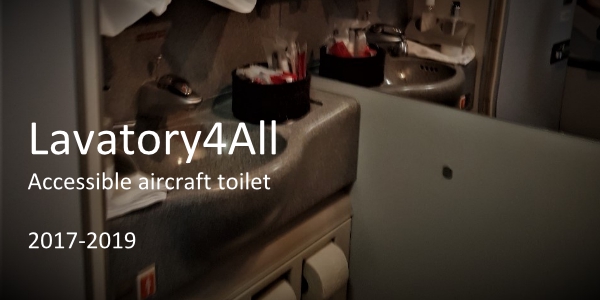Lavatory4All

The use of airplane toilets is difficult or not possible at all for many persons with limited mobility. Lavatory4All aims to provide solutions for barrier-free aircraft toilets that meet the needs of affected persons and airlines.
Client: bmvit, Take Off, Tender 2016
Duration: September 2017 to August 2019 (24 months)
Project partners: FH JOANNEUM Graz, Institute of Aviation; TU Vienna, Institute of Transport Sciences; Rodlauer Consulting GmbH; FACC AG; TU Vienna, Institute for Design and Impact Research; Raltec – Research Group for Assisted Living Technologies
LOI partners: Flughafen Salzburg AG; ÖBR – Österreichischer Behindertenrat; Re-mobility; Club 81 – St.Pölten; equality; Caritas Sozialis – Multiple Sclerosis Day Centre; Multiple Sclerosis Society Vienna; knack:punkt – selbstbestimmt Leben Salzburg; Safe-Runway GmbH
Project description: The use of an aircraft toilet is very difficult for many persons with reduced mobility or especially on short- and medium-haul flights, often not possible at all. Depending on the type of reduced mobility, there are different and often contradictory requirements for the design of toilets, which often conflict with technical possibilities in aircraft construction or the economic framework conditions of airlines. For economic reasons, the space in an aircraft cabin must be used in the best possible way, which prevents the generous design of toilets that is often necessary for passengers with limited mobility and required by terrestrial construction standards. Furthermore, high demands are placed on the material of any aircraft interior with regard to the required strength and at the same time with regard to the required weight minimisation.
Aircraft toilets do not meet the generally applicable standards with regard to accessibility as implemented in the construction industry or in railway coaches. In addition to relatively simple measures, e.g. for blind or visually impaired persons, the requirements of passengers with disabilities or those who are dependent on the use of an onboard wheelchair represent major challenges that have not yet been solved. However, due to national and international laws and regulations on non-discrimination that are already in force or are currently being drafted, it is to be expected that in a few years more stringent accessibility requirements will also be imposed on air traffic.
Barrier-free aircraft toilets must be designed from a holistic perspective so that they actually meet the most diverse requirements of all persons regardless of disability (research according to the principles of “Universal Design”, “Design for All” and “Participatory Design”). At the same time, they must also meet the high requirements of aviation with regard to the best possible space utilisation, the safety of the materials required and the lowest possible weight.
The aim and content of the Lavatory4All project is, in cooperation with potential users, airlines and suppliers, to develop the fundamental principles for a comprehensive barrier-free aircraft toilet, which meets the high requirements of aviation in terms of safety and economy and due to its design brings clear benefits for all passengers, especially for passengers with limited mobility. In the project, all requirements for a barrier-free aircraft toilet are collected and prepared in depth (by means of surveys, expert discussions and workshops) both from the perspective of persons with limited mobility and from the perspective of aviation (airlines and industry). Based on these findings, a barrier-free aircraft toilet is designed and evaluated in several feedback loops with affected persons, airlines and the industry.
For a realistic evaluation, a modular and flexible mock-up made of wood is created, which can be adapted at short notice with regard to its functionalities and dimensions. In several workshops, people with limited mobility are invited and asked to test the mock-up and give concrete feedback on necessary changes. The aim of this mock-up is to explore the limits of feasibility with regard to the smallest possible space with full functionality. In parallel, experts within the consortium, including external experts, will answer the question of whether and how the requirements can be implemented from the point of view of persons with limited mobility, taking into account specific air-traffic requirements. This applies in particular to the design elements and the choice of materials.
Result and added value of Lavatory4All is the feasibility check and rule creation for an aircraft toilet that meets all requirements of (mobility) disabled persons as far as possible and also meets the strict general conditions from the perspective of aviation (safety, weight, reliability, hygiene, failure probability, maintenance and cleaning). The aim is to develop a system that can be used universally in both short and long-distance traffic.
Contact: DI Dr. Bernhard Rüger
